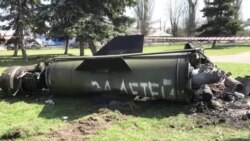On April 8, 2022, the Ukrainian authorities and news reports said a rocket attack killed at least 52 people, including five children, on a railway station in the city of Kramatorsk in eastern Ukraine.
Ukraine said Russian forces deliberately targeted the station, an evacuation hub for civilians fleeing the war, with two ballistic missiles. About 100 people were wounded, according to news reports and Ukrainian officials.
Russia quickly denied responsibility and blamed Ukraine.
"All statements by representatives of the Kyiv nationalist regime about the 'rocket attack' allegedly carried out by Russia on April 8 at the railway station in the city of Kramatorsk are a provocation and are absolutely untrue," the Russian Defense Ministry said, according to a report by The New York Times.
As proof, the ministry claimed that only Ukrainian forces employ the Tochka-U ballistic missiles said to have been used in the strike.
"We emphasize that Tochka-U tactical missiles, fragments of which were found near the Kramatorsk railway station and published by eyewitnesses, are used only by the Ukrainian armed forces," the defense ministry claimed.
A pro-Russian militia leader in the Donbas said the same thing.
"I underline, it's a rocket, Tochka-U, we don't have such a weaponry in our republics, Donetsk and Luhansk, and in the Russian Federation in the army they don't have it either," Eduard Basurin, deputy head of the Donetsk militia, told the Russian TV1 channel.
This is likely false. Evidence shows that Russian convoys trucked Tochka-U systems into Belarus. And Russia reflexively blames Ukraine for attacks on civilians, no matter abundant evidence otherwise.
Ukrainian President Volodymyr Zelenskyy blamed the Kramatorsk attack on Russian-fired Tochka-U missiles. Also known as the SS-21, the Tochka is a mobile, single-warhead system that can launch in ballistic or cruise modes, according to a Center for Strategic International Studies Missile Threats report published in March. The weapons were developed in the 1970s by the Soviet Union.
In 2018, the Russian defense ministry proudly advertised Tochka-U system in a YouTube video:
"It is believed that Russia currently possesses 300 TEL [launch] vehicles and 310 nuclear warheads for all versions of the Tochka" and that Ukraine has about 500 Tochka-U versions, a model introduced in 1989, the center reported.
The Russian state-owned newspaper AIF reported in 2017 that the Russian army started using the Tochka-U in 1989. A website affiliated with the Russian armed forces, "Voennoe Obozrenie," praised the Tochka-U system for reliability, comparing it with the Kalashnikov, Russia's famed automatic assault rifle.
According to open-source reports, the Russian army has used Tochka-U missiles in Chechnya in the 1990s, in Syria, multiple times in Ukraine since the beginning of war in 2014 and including on the first day of its full-scale invasion February 24.
On that day, the fragments of a rocket that hit a hospital in the village of Vugledar in eastern Ukraine, killing four and wounding more than 10 people, were identified as a Tochka-U system launched by the Russian army, according to the Twitter account Ukrainian Weapons Tracker.
Ukraine has also reportedly used Tochka-U systems in Donbas in 2014 and in March under the new Russian offensive.
An open-source investigative news site, the Belarusian Hajun project, twice published videos of Russian military columns marked with a letter "V" moving toward the Ukrainian border, on March 5 and March 30. The first column included "at least 30" and the second "at least 8 Tochka-U" systems, the site tweeted.
Russia's deployment of about 30 Tochka-U systems to Belarusian borders near Ukraine also were reported by Telegram users on March 5.
At the Kramatorsk strike, photos show a chunk of debris from a large rocket on which the words "for children" were written in Russian.
Ukrainian authorities said about 4,000 people were awaiting evacuation at the station when the missiles hit on the morning of April 8.
In a post on the incident, the Atlantic Council's Digital Forensic Research Lab, a U.S. watchdog site, reported that:
"Russian Telegram channel Siloviki prematurely published information that Russians are 'working on a cluster of armed forces of Ukraine at Kramatorsk railway station' and celebrated casualties among Ukrainian combatants. "A few minutes after the initial post, they edited it, presumably after reports of civilian casualties proliferated. In the edited post, they said that when the Kramatorsk railway station was hit, 'It was possibly a Tochka-U [missile] that the Armed Forces of Ukraine use.' "Both posts were subsequently deleted, but the original post and the edited message were archived as a forwarded message on another pro-Kremlin channel."Other teams of investigative journalists also reported that the Russian denials are likely false. The Conflict Intelligence Team (CIT), a group of Russian journalists, said missiles that hit the Kramatorsk station likely came from the southeast, where the Russian Tochka-U systems are positioned.








